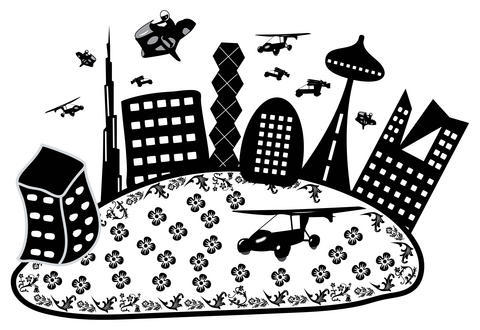Civil aeronautics is in the midst of becoming a "mature" industry, with all the drawbacks that this entails. For decades, technological advances have been essentially incremental and the industry remains largely based on long-haul transport aircraft, with an emerging small jet component and a legacy of general aviation markets and products. But it has become increasingly clear that the industry cannot survive in this form.
The problems bedeviling the industry include pollution from emissions, increasing competition (particularly from communications technology, which has made business travel less necessary), air traffic control delays and inefficiencies, expanding noise restrictions, safety and security concerns and an overall business environment highly dependent on fuel prices. Solutions for all of these problems will probably require a complete reinvention of airplane technology.
The greatest hope is to be found in the ongoing information, bio-, nano-, energetics, and quantum technology revolutions. The IT revolution and associated "swarm" technologies enable the foremost solution: A "digital airspace" that is wholly automatic in terms of air traffic control, navigation and vehicle operations. Automatic aircraft operation is already becoming commonplace, but further increases will require a similarly automatic airspace.

ILLUSTRATION: LANCE
A digital airspace would in turn enable a complete revolution in personal mobility. Together with new technologies enabling Super-Short Takeoff and Landing (superSTOL) a digital airspace would put safe, quiet, affordable, street-in-front-of-your-house personal air vehicles within sight. So-called flying high mobility multipurpose wheeled vehicles (HumVees) would create a superb transportation system for areas lacking intercity roads and eventually would supplement -- or perhaps supplant -- cars.
The variety of machines currently under study is accessible at www.roadabletimes.com.
The estimated worldwide market for such vehicles is in the range of US$1 trillion and their use would erode the scheduled domestic airline customer base by enabling 300km "commutes" and providing huge cost avoidance for roads and bridges.
Nevertheless, even given eventual development of an affordable, safe, fly/drive, airport-independent personal transportation system, there would still be a need to reinvent long-haul transport, especially for transoceanic flights. The current machines of this genre are direct descendants of the Boeing 707 and, after many decades of evolutionary improvement, this design approach simply lacks the scope to address the many problems that must be solved.
There are several alternatives, such as the blended wing body and strut/truss braced wings, which offer major potential increases in lift-to-drag ratio and improvements in structural weight fraction. Such improvements in these parameters would provide design margins to address most of the current problems, with the exception of emissions.
The issue of water emissions can be addressed by designs that enable long-haul aircraft to cruise below 9,000m. Such designs could be enabled by using circulation control for high lift and employed at cruising altitude for ride quality. The resulting STOL (short takeoff and landing) performance could also improve airport productivity.
On the other hand, emissions of carbon dioxide can be reduced simply by using biofuels, made from plants whose carbon dioxide "price" was paid via uptake of the very same gas from the atmosphere during their growth. Reductions of other greenhouse gases, such as nitric oxide, are attainable through clever combustor design.
Given the number and severity of problems currently plaguing civil aeronautics, the conventional approach of evolutionary changes to current paradigms is no longer sufficient. Instead, the industry must re-invent itself. With the advent of a digital airspace, and with appropriate research support, success would be both possible and likely.
Dennis Bushnell is chief scientist at the NASA Langley Research Center in Virginia. Copyright: Project Syndicate
Concerns that the US might abandon Taiwan are often overstated. While US President Donald Trump’s handling of Ukraine raised unease in Taiwan, it is crucial to recognize that Taiwan is not Ukraine. Under Trump, the US views Ukraine largely as a European problem, whereas the Indo-Pacific region remains its primary geopolitical focus. Taipei holds immense strategic value for Washington and is unlikely to be treated as a bargaining chip in US-China relations. Trump’s vision of “making America great again” would be directly undermined by any move to abandon Taiwan. Despite the rhetoric of “America First,” the Trump administration understands the necessity of

US President Donald Trump’s challenge to domestic American economic-political priorities, and abroad to the global balance of power, are not a threat to the security of Taiwan. Trump’s success can go far to contain the real threat — the Chinese Communist Party’s (CCP) surge to hegemony — while offering expanded defensive opportunities for Taiwan. In a stunning affirmation of the CCP policy of “forceful reunification,” an obscene euphemism for the invasion of Taiwan and the destruction of its democracy, on March 13, 2024, the People’s Liberation Army’s (PLA) used Chinese social media platforms to show the first-time linkage of three new

If you had a vision of the future where China did not dominate the global car industry, you can kiss those dreams goodbye. That is because US President Donald Trump’s promised 25 percent tariff on auto imports takes an ax to the only bits of the emerging electric vehicle (EV) supply chain that are not already dominated by Beijing. The biggest losers when the levies take effect this week would be Japan and South Korea. They account for one-third of the cars imported into the US, and as much as two-thirds of those imported from outside North America. (Mexico and Canada, while
The military is conducting its annual Han Kuang exercises in phases. The minister of national defense recently said that this year’s scenarios would simulate defending the nation against possible actions the Chinese People’s Liberation Army (PLA) might take in an invasion of Taiwan, making the threat of a speculated Chinese invasion in 2027 a heated agenda item again. That year, also referred to as the “Davidson window,” is named after then-US Indo-Pacific Command Admiral Philip Davidson, who in 2021 warned that Chinese President Xi Jinping (習近平) had instructed the PLA to be ready to invade Taiwan by 2027. Xi in 2017